ABOUT THE SECTION 125 POP with HSA MODULE
Save an extra 8% with HSA deductions through the Section 125 Premium Only Plan
Now employers can offer a Health Savings Account (HSA Deductions, Section 125) as part of their employees’ Section 125 Cafeteria plan. Our Core HSA Plan Document package makes it easy and affordable to expand employee options and reduce the cost of health coverage, all while maximizing tax savings for everyone.
The $149 Section 125 Plan plus the $30 HSA Module from Core Documents allows both an employer and employee to realize more HSA tax savings — an additional 8% — by using pre-tax employee dollars to fund a Health Savings Account (HSA).
What is an HSA?
Health Savings Accounts are employee-owned medical savings accounts with premium tax-saving benefits.
The distinct tax-advantaged treatment of Section 125 HSA contributions lets it serve two purposes for the
account owner:
- The HSA uses tax-free dollars to reimburse eligible medical expenses incurred by the account owner or covered dependents as needed; and,
- HSA accounts also serve as investment vehicles for retirement, when distributions can be used to pay for health care (tax-free) or other expenses.
Quick-links
(Click a link below to drop to that section)
Why should an employer offer an HSA in a Section 125 Cafeteria plan?
How does it work?
How to start a Section 125 HSA for employees
Why should an employer offer an HSA in a Section 125 Cafeteria plan?
Offering employees access to an HSA through a company’s Section 125 Cafeteria plan has three perks for the employer:.
- Lower group health premium for employees with an HSA;
- FICA and other payroll tax savings on employees’ HSA contributions; and,
- Improved overall employee benefits package
Lower group health premium for employees with an HSA
Any employee choosing to open and contribute to an HSA must be covered by a high-deductible health plan (HDHP); people with traditional health coverage are not eligible to participate.
When an employer offers an HSA through its Section 125 Cafeteria plan, the company will also provide an HDHP
option for those employees. This almost always means a group policy with a higher annual deductible and out-of-pocket maximum than the group coverage already available, which results in a reduced group health premium for employees choosing an HSA.
An employer could save thousands of dollars per year on group health premiums (and substantial premium savings for the employee as well) through the lower cost of an HSA’s required HDHP alone.
FICA and other payroll tax savings on employees’ HSA contributions
Most people think of paying for Cafeteria plan benefits as a salary deduction. According to the IRS, however, it is a salary reduction because, technically, the employee chooses to receive the Section 125 benefit instead of salary.
Whether it is an insurance premium or HSA contribution, that amount is no longer counted in the employee’s wages. In turn, the amount is not subject to FICA, FUTA, and other state and local payroll taxes. This is a savings of between 8% and 10% for most employers.
Improved overall employee benefits package
It is likely that you have employees who would like to set up an HSA but do not meet the primary eligibility
requirement – coverage under a high-deductible health plan (HDHP). Making both available in your health benefit plan options will be a welcome opportunity to these employees.
A Cafeteria plan with plenty of choices is also attractive to potential employees, and will make your efforts to hire top-quality candidates more successful.
Non-Cafeteria plan HSAs
Unlike an FSA or HRA, an employee can open an HSA on their own – outside of an employer’s benefit plan – so long as the employee’s health insurance meets the HDHP requirements set for an HSA. In this situation, the employee would take the HSA income tax benefit when filing taxes that year.
However, the employee misses an additional 7.65% FICA tax savings available only when the HSA is funded
through the employer’s Section 125 Cafeteria plan. And, the employer loses the potential FICA tax savings
plus reduction of FUTA and (in most states) state unemployment or workers’ compensation taxes.
When an employer provides an HSA option through its benefit plan, an employee may opt to capture those lost
tax savings by switching to the employer’s HSA. Plus, the employee doesn’t have to wait for a tax refund to
benefit from the HSA tax advantages and the employer reduces taxes, too.
Plan Document Required
All the IRS requires for tax-advantaged treatment of Cafeteria plans – including a Health Savings Account – is that a written plan document be completed by and on file with the employer.
Employers with an existing Section 125 plan document must update it to include the HSA and any new limited FSA options.
HDHP Rules
The IRS sets an inflation-adjusted minimum annual deductible and out-of-pocket plan limit each year for HSA-qualifying HDHPs. Here are the current figures:
Contribution and Out-of-Pocket Limits
for Health Savings Accounts and High-Deductible Health Plans |
|
2024 |
2025 |
Change |
| HSA contribution limit (employer + employee) |
Self-only: $4,150
Family: $8,300 |
Self-only: $4,300 Family: $8,550 |
Self-only: +$150
Family: +$250 |
| HSA catch-up contributions (age 55 or older) |
$1,000 |
$1,000 |
No change (set by statute) |
| HDHP minimum deductibles |
Self-only: $1,600
Family: $3,200 |
Self-only: $1,650 Family: $3,300 |
Self-only: +$50 Family: +$100 |
| HDHP maximum out-of-pocket amounts (deductibles, co-payments and other amounts, but not premiums) |
Self-only: $8,050
Family: $16,100 |
Self-only: $8,300 Family: $16,600 |
Self-only: +$250
Family: +$500 |
| Source: IRS in IRS Rev. Proc. 2024-25 |
The contribution limits above are for total contributions to an HSA from employee and/or employer:
Contributions
Health Savings Accounts may be funded by the employee, employer, or both:
- HSA funds are deposited into the employee’s HSA bank or investment account. Interest earned on the
account is tax-free to the employee.
- The contribution limit for an HSA is determined by the type of HDHP coverage (self-only vs. family). It is set by the IRS and adjusted for inflation each year.
- In addition, the IRS provides a catch-up provision for account owners age 55 and older with an allowance of $1,000 per year.
Contributions may come from the employee, the employer, or both, so long as the total amount abides by the annual limit set by the IRS.
Employee contributions
In a Section 125 HSA, employee contributions are taken as pre-tax salary deductions according to the election form completed during open enrollment period.
The annual election amount is not pre-funded; however, funds deposited into an HSA are immediately available to pay or reimburse eligible medical expenses.
Employer contributions
Employers often choose to contribute to employees’ HSA accounts. These deposits go into the same bank or investment account as the employee’s contribution goes and are immediately vested.
Health care expenses
Funds deposited into a Health Savings Account are immediately available for the employee to use to pay (using an HSA debit card) or reimburse themselves for eligible medical expenses.
Generally, eligible medical expenses under an HSA are explained in Publication 502,Medical and Dental Expenses.
For more information on this topic, read: HSA-eligible medical expenses and purchase options.
There is no surrender of unused contributions to an HSA at the end of a plan year. Funds remain in the bank
or investment account, accruing interest, until the account owner/employee calls upon it to pay medical
expenses.
HSA with Health FSA
To be eligible for the HSA, the employee may not also have other health coverage that could pay the HDHP
deductible. This means that an employee cannot have an HSA and a standard Health FSA at the same time.
If an employee with a Health FSA plans to open an HSA in the next plan year, the Health FSA must be spent down to zero or surrendered before the start of a new plan year.
For example, the employee will change to the HDHP with HSA on the first day of the plan year (January 1), so must either spend or surrender the Health FSA by December 31 of the previous year. The Health FSA cannot be
carried into the new plan year with a carry-over or grace period provision.
Limited FSAs for HSA participants
An employee may have an FSA that is limited by design to only pay expenses outside of the HDHP deductible.
For those employees, an employer may include in the Section 125 plan document:
Post-deductible FSA
Only pays benefits after the HDHP deductible has been satisfied.
Limited Purpose FSA
Pays dental, vision and other medical expenses not covered by the HDHP
Retirement
At retirement age, the account may still be used for tax-free medical expenses.
Also, HSA distributions may be taken for a non-medical purpose without incurring the 20% tax penalty.
Many employers use a dollar-match incentive to encourage employee savings for retirement as well as to help employees’ build retirement savings.
↑ Return to top
How to start a Section 125 HSA for employees
To meet the Section 125 written plan document requirement to pre-tax HSA contributions, an employer’s
existing Cafeteria plan document must be updated to include the HSA module.
Core Documents provides employers with everything they need to establish an IRS-and DOL-compliant plan with its $179 CoreHSA plan document package (.pdf). This cost reflects a one-time setup fee, not an annual subscription fee.
Setting up the CoreHSA plan document
- The CoreHSA plan document package is delivered signature-ready in .pdf format via email, usually the same business day it is ordered.
- Upon receipt, the employer will:
- Sign the plan document in the two places indicated;
- Distribute the Summary Plan Description (SPD) and election forms to all employees; and,
- Collect completed election forms from employees participating in the plan.
Filing Requirements
The HSA plan document must be kept on site so it is available in the event of an IRS audit or DOL inquiry, or if an employee asks to view it.
The plan document does not need to be filed with any governmental entity
Accounting
Section 125 HSA contributions can accumulate in the general asset account of the company until payment is due; a separate HSA trust account is not necessary.
Maintenance
No annual fee — Core Documents will notify you when there are sufficient changes in the Code to require amending and restating your Plan. You can amend and update anytime, and only when necessary, which is the most cost-effective way to maintain a Section 125 HSA Plan.
Fast Service — Most orders placed by 3 PM are returned via email the same day, Monday through Friday. Weekend orders are sent out Monday morning. Plan document packages are processed in the order received. During our busiest months (December, January, and February), the rush order fee (see order form) marks your document to be processed immediately.
Refund Policy: Goods and services provided by Core Documents, Inc. are non-refundable upon receipt. Orders cancelled prior to shipping are subject to a fee to cover the cost of goods and services provided during the review, draft, and preparation of your order.
Additional Resources
Contact Us
Want to make sure you’re choosing the tax-saving options best for your particular situation? Get in touch with an expert on Section 125 HSA plan design. Send us an email or call our friendly, knowledgeable staff at 1-888-755-3373.
Section 125 Plan Brochures (with forms)
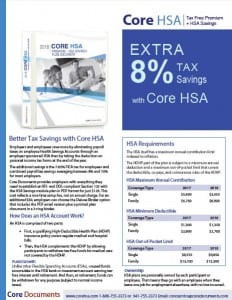 CoreHSA brochure and forms (click image to download).
|
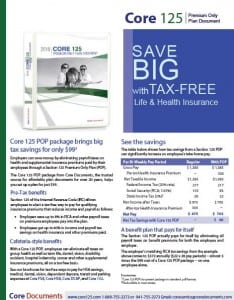 Core125 brochure and forms (click image to download).
|
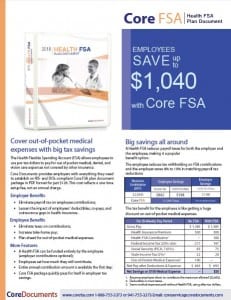 CoreFSA brochure and forms (click image to download).
|
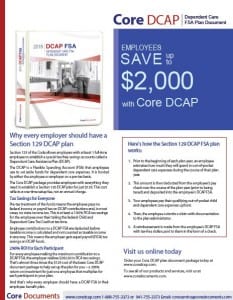 CoreDCAP brochure and forms (click image to download). |
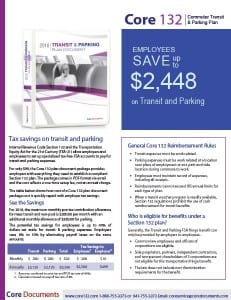 Core132 brochure and forms (click image to download). |
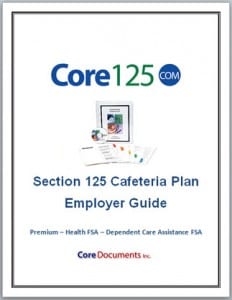 Cafeteria Plan Employer Guide (click image to download). |